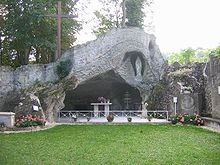Mournouards II
Mournouards II is one of three rock tombs ( French hypogeus ) at a place called La Mournouards in Le Mesnil-sur-Oger , south of Épernay in the Marne department in France .
The first of the rock tombs belonging to the Marnegrotten was discovered destroyed in 1845. The chamber was round, with a surrounding bank altar . The skeletal parts lay in groups on the bank altar.
The second La Mournouards I is a simple chamber without an antechamber (French antégrotte ). The work on the cave resulted in the accidental destruction of the ceiling of Mournouards II.
description
Mournouards II is a hypogeum with an antechamber ( French hypogeus antégrotte ) whose main chamber is divided into a larger front (3/5) and a smaller rear (2/5) area by means of lateral, slightly offset constrictions. It is oriented northwest-southeast, with the access in the southeast. It was built in the chalk cliffs of the Côte d'Ile-de-France. The access under the vineyard was completely filled in and could not be examined.
Antechamber
The oval antechamber, 1.75 m wide and 1.1 m long, lies in the middle of the chamber. The vaulted ceiling is a maximum of one meter high. The antechamber is separated from the chamber by a 0.75 m high, 0.5 m wide and about 0.75 m long hatch ( French petite chatière - German "cat flap" ). The locking device was found in the antechamber. It consists of a plate. A groove in the bottom and on the top is used for fixation.
Main chamber
The main chamber measures approximately 5.0 mx 3.0 m. The average height is only 1.15 m. To the side of the hatch, inside, 0.15 m above the floor, there are two altar niches 0.30 m wide. A third is in the back of the chamber. A thin layer of chalk covers the almost flat floor. It contained about 80 individuals who were used during two phases of use - 3300 and 3000 BC. Were introduced.
The excavation allows a precise description of the architecture, the collection bowl and the bones. The location of the newcomers inspired André Leroi-Gourhan to assume individual and collective burials. He was able to distinguish eight bearings of arrowheads (5 in the end chamber, two on the sides of the front chamber area and one in the antechamber) belonging to 93 arrows. The distribution of the 79 corpses (41 adults, 14 young people, 24 children) corresponds to that of the arrows. 50 of them belong to the oldest occupancy phase. According to A. Leroi-Gourhan, the corpses were deposited in a shroud that did not cover the head, lying on their back.
Time position
After the analysis of the Einbringsel, the grave was a system of the Seine-Oise-Marne culture (SOM culture), a monolithic culture between the Chasséen and the Bronze Age (3350-3000 BC) originally by A. Leroi-Gourhan The data obtained did not fit into the period of the late Neolithic SOM culture.
The excavation of Mournouards II by André Leroi-Gourhan in 1962 marked a turning point in the history of research into collective graves. Fifty years later, it became necessary to revise the dates in order to place the monument in the context of recent archaeological discoveries. An anthropological study was done to analyze the bones. This has helped to suggest the temporal dimension of the hypogeum. It was thus possible to differentiate between two phases of use. Through this information three areas were revealed, characterized by different levels of individual and collective landfilling.
literature
- Arnaud Blin: Une nouvelle analyze de l'hypogée neolithique des Mournouards II au Mesnil-sur-Oger (Marne). In: Revue Archéologique de l'Est. Vol. 61, 2012, ISSN 1266-7706 , pp. 35-54, ( online ).
Web links
Coordinates: 48 ° 56 ′ 42.4 " N , 4 ° 0 ′ 56.9" E
